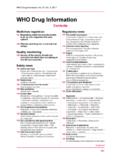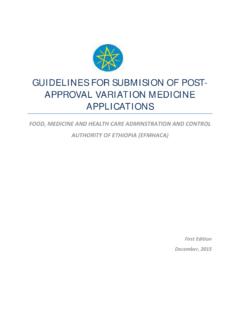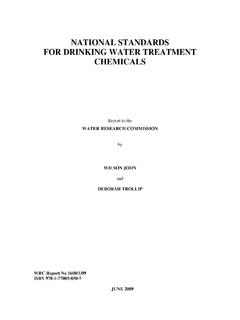Transcription of Exposure to Lead in Great Britain 2016
1 Health and Safety Executive Exposure to Lead in Great Britain 2016. Medical Surveillance of Blood-Lead Levels in British Workers 2015/16. Contents Summary 2. Introduction 3. Workforce under medical surveillance 4. Lead based industry distribution 5. Males under surveillance 5. Females under surveillance 6. Blood-lead levels in British workers 7. Male blood-lead levels 7. Female blood-lead levels 8. Suspensions 10. Male suspensions 10. Female suspensions 10. Appendix 1 11. This document is available from Page 1 of 12. Summary This document describes the latest statistics for blood-lead measurements taken under statutory medical surveillance for work with lead during 2015/16. The document can be found at There has been an overall reduction in the number of British workers under medical surveillance for work with lead over the past decade. Women have consistently accounted for a small proportion of the total under surveillance, and the number of young people (under 18 years) under surveillance remains very low.
2 The number and proportion of workers with higher levels of blood-lead concentrations have decreased substantially over the past decade. The most recent data for 2015/16 show: There were 6451 workers under medical surveillance, a rise of 1% compared with the previous year. Male workers accounted for 6139 (95%) of those under surveillance. Just over 83% of men and 99% of women under surveillance had blood-lead levels below 25 g/100ml. There were 57 men with levels of 50 g/100ml or above, and 13 men with levels at or above the suspension level of 60 g/100ml. There were 3 women with levels of 25 g/100ml or above. Nine individuals (all male) were suspended due to excess blood-lead. The industry sector with the highest number of males under surveillance was the smelting, refining, alloying and casting sector. Work involving metallic lead and lead containing alloys accounted for the highest number of females under surveillance. 9000. 8000. Workers under surveillance 7000.
3 6000. 5000. 4000. 3000. 2000. 1000. 0. 05/06 06/07 07/08 08/09 09/10 10/11 11/12 12/13* 13/14 14/15 15/16. * Figures f or 2012/13 are estimates which correct f or undercounting in the originally published f igures (see Appendix 1). Figure 1 The total number of British lead workers under medical surveillance since 2005/06. This document is available from Page 2 of 12. Introduction Exposure to lead can result in a range of serious medical problems, which is why a regime of surveillance of workers in lead industries is undertaken in Great Britain . Under the Control of Lead at Work (CLAW) Regulations all workers with significant Exposure to lead are required to undergo medical surveillance which includes measurement of blood-lead concentrations. However the decision to put workers under surveillance rests with the employer. The regulations specify blood-lead concentration levels ( g/100ml) at which an appointed doctor is to decide if a worker should no longer be exposed to lead (known as the suspension level').
4 In 1998, updated regulations introduced a lower action level' at which employers must take additional steps to help ensure worker's blood-lead levels are reduced. Since 1998/99, separate information has been collected on young people (aged under 18 years) under medical surveillance. Before the introduction of the CLAW Regulations in August 1981, there were ten individual regulations that covered the use of lead, including regulations on paint and colour manufacture', lead smelting and manufacture' and lead compounds manufacture'. Table 1 Summary of the Control of Lead at Work (CLAW) Regulations 1980, 1998 and 2002. CLAW Regulations 1980 CLAW Regulations 1998 and 2002. April 1998. Came into force August 1981. Unchanged in November 2002. Calendar years 1982-1986. Collection Financial years Financial years 1987/88 onwards Male and other workers 80 g/100ml 1982-1985. Suspension level 60 g/100ml 70 g/100ml 1986 onwards Action level - 50 g/100ml Female workers of reproductive capacity Suspension level 40 g/100ml 30 g/100ml Action level - 25 g/100ml Young workers (aged under 18 years).
5 Suspension level - 50 g/100ml Action level - 40 g/100ml HSE's Medical Inspectors, HSE Appointed Doctors (who are the main group of doctors carrying out statutory medical surveillance of lead-exposed workers in GB), and a body of scientific evidence would indicate that it is often the case that individuals with blood-lead levels at or above the suspension limit and who are suspended from working with lead do not have symptoms normally described as lead poisoning . Such workers are therefore removed from further Exposure to lead to reduce the likelihood of such symptoms developing. The coverage of these statistics is limited by the extent of medical surveillance that occurs in practice, and this may not be completely aligned with what is required under the CLAW regulations. Some employers may keep workers under surveillance on a precautionary basis where Exposure is not likely to be significant, whereas others may fail to implement surveillance where it is in fact required.
6 A more detailed discussion of the basis for the statistics and their potential limitations is available on the data sources page, see for more information. This document is available from Page 3 of 12. Workforce under medical surveillance The number of workers under surveillance provides an indication of the extent of potential occupational lead Exposure in the British population. Figure 2 shows the number of male and female workers under medical surveillance each year since 1996. 20000. Females Workers under surveillance 15000 Males 10000. 5000. 0. 96/97 97/98 98/99 99/00 00/01 01/02 02/03 03/04 04/05 05/06 06/07 07/08 08/09 09/10 10/11 11/1212/13*13/14 14/15 15/16. * Figures f or 2012/13 are estimates which correct f or undercounting in the originally published f igures (see Appendix 1). Figure 2 The total number of British lead workers under medical surveillance since 1996/97 by sex There were 6451 workers (6139 males and 312 females) under medical surveillance in 2015/16 (Table 2), an increase of 1% from the 6374 under medical surveillance in 2014/15.
7 There has been a long-term downward trend in the numbers under surveillance over the last two decades, which shows some signs of levelling off. Similar reductions have been seen among both men and women. Women have accounted for only a small proportion of the total under surveillance over this period (5% of all workers under medical surveillance in 2015/16). The number of young people (under 18 years) under medical surveillance remains low, with 4 young males in 2015/16. Table 2 Breakdown of workers under medical surveillance % %. Year Males Females Total Males Females 2005/06 8278 (12) 96% 340 (10) 4% 8618 (22). 2006/07 8376 (4) 96% 321 (4) 4% 8697 (8). 2007/08 7752 (7) 96% 317 4% 8069 (7). 2008/09 6563 (19) 96% 268 (3) 4% 6831 (22). 2009/10 6916 (8) 97% 246 3% 7162 (8). 2010/11 7214 (6) 97% 258 3% 7472 (6). 2011/12 7689 (14) 97% 260 (1) 3% 7949 (15). 2012/13* 6232 (1) 95% 294 5% 6526 (1). 2013/14 6505 (1) 96% 301 4% 6806 (1). 2014/15 6075 (6) 95% 299 5% 6374 (6).
8 2015/16 6139 (4) 95% 312 5% 6451 (4). * Figures for 2012/13 are estimates which correct for undercounting in the originally published figures. Figures are for the total number of workers, of which the number under 18 years of age is given in brackets This document is available from Page 4 of 12. Lead based industry distribution The current set of industry sector categories apply to statistics for 2010/11 onwards and were produced to best reflect the main industry sectors in which lead Exposure may currently occur. Lead battery and glass recycling are identified separately from battery and glass manufacture, and a category for the paint removal sector is also included. The other processes' category includes any industries not covered by the specific categories. Males under surveillance The smelting, refining, alloying and casting sector has consistently accounted for the highest number of males under medical surveillance over the last 5 years, and in 2015/16 accounted for 20% of all males under surveillance.
9 In 2015/16, the next two sectors with the highest number of workers under surveillance were the lead battery manufacturing sector (11% of all male workers), and industries involving work with metallic lead and lead containing alloys (10% of all male workers). One noteworthy change was that the scrap industry had around 345 males under surveillance in 2014/15, but this rose to 530 in 2015/16. This appears to be partly due to an increase in the number of males under surveillance for one particular company within this sector. Other changes in the number of males under surveillance between 2014/15 and 2015/16 include an increase in the lead battery manufacture sector, from 585 to 665; a rise in the glass recycling sector, from 35 to 115; a decrease in workers in the paint removal sector, from 765 to 580; and a reduction in number in the smelting, refining, alloying and casting sector, from 1330 to 1220. 1. Smelting, refining, alloying and casting 14.
10 Work with metallic lead and lead containing alloys 2. Lead battery manufacture 13. Paint removal 15. Scrap industry (including pipes, flashing, cables). 9. Manufacture of inorganic and organic compounds (including lead salts, fatty acids). 12. Painting of buildings and vehicles 3. Lead battery recycling Industrial Sector 11. Demolition industry 5. Glass making (including cutting and etching). 2010/11. 4. Badge and jewellery enamelling and other vitreous enamelling 2011/12. 6. Glass recycling (including TV and monitors). 2012/13*. 10. Shipbuilding, repairing and breaking 2013/14. 7. Manufacture of pigments and colours 2014/15. 2015/16. 8. Potteries, glazes and transfers 16. Other processes 0 200 400 600 800 1000 1200 1400 1600. * Figures for 2012/13 are estimates which correct for undercounting in the originally published figures (see Appendix 1) Male workers under surveillance Figure 3 The breakdown of male lead workers under medical surveillance since 2010/11 by industrial sector This document is available from Page 5 of 12.















